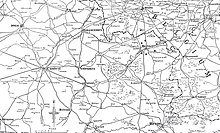Battle of Le Cateau
| date | August 26, 1914 |
|---|---|
| place | at Le Cateau-Cambrésis , France |
| output | Retreat of the Entente |
| Parties to the conflict | |
|---|---|
| Commander | |
|
Alexander von Kluck |
Horace Smith-Dorrien |
| Troop strength | |
| 3 infantry and 3 cavalry divisions, altogether about 55,000 men | 3 infantry and 1 cavalry division, about 40,000 men |
| losses | |
|
approx. 3,000 |
7,812, including 2,600 prisoners, |
The Battle of Le Cateau took place on August 26, 1914 during the First World War .
prehistory
After the Battle of Mons (23 and 24 August 1914), British and French troops, including the II Corps of the BEF under General Horace Smith-Dorrien , withdrew fighting at Le Cateau-Cambrésis and took up defensive positions there against those who were pursuing them Units of the German 1st Army by Alexander von Kluck . Smith-Dorrien's three divisions and a small cavalry corps had been cut off from General Douglas Haig's I Corps and had been in retreat for days. The commander-in-chief of the BEF, General John French , had ordered a further withdrawal for August 26th. Smith-Dorrien decided, however, to face battle with his troops in Le Cateau, as he believed, due to the proximity of the pursuing German troops, that there would be a battle even if the retreat continued. He also hoped that a fight would have a positive effect on the morale of his troops, which had been exhausted from several days of withdrawal. Fortunately for the British, only three German infantry and three cavalry divisions of the 1st Army took part in the battle; further reinforcements were stopped by French troops.
battle
On the morning of August 26th, the German 4th Cavalry Division (General Otto von Garnier ) encountered the enemy while advancing south, and the IV Army Corps under General Sixt von Armin came via Solesmes with the 7th and 8th Division and took the British positions at Le Cateau under heavy artillery fire. To the west against Cambrai , General von der Marwitz's cavalry ( 2nd and 9th Cavalry Divisions ) covered the right flank and pursued Beauvois and Caudry , where the British with General Allenby's cavalry and their 4th Division (General Snow ) a locking bolt had built. The British 3rd (General Hamilton ) and 5th (General Fergusson ) divisions defended the positions at Le Cateau , both units bearing the brunt of the battle. The English batteries were quickly smashed and the Germans took Le Cateau after a bitter street fight.
At noon began the concentrated attack of the German infantry on the British entrenched in quickly dug, shallow trenches. The British initially managed to hold their position, but in the afternoon both flanks began to give way. From the east, the German 5th Division (General Wichura ) of III. Corps intervened in the battle. The arrival of French cavalry ("Corps de cavalerie Sordet") under General Sordet was able to strengthen the left flank early on, but the threat of encirclement by the approach of the German IV Reserve Corps forced the British to give up their positions. The British 2nd Corps was able to delay the advance of the German 1st Army for eleven hours.
At night the Allies withdrew to Saint-Quentin . Of the 40,000 Allies, 7,812 were killed, wounded or captured. Several British regiments were destroyed. 38 guns had to be left behind by the Allies; the majority could be disabled. According to British (unconfirmed) information, the German losses were the same. However, more recent research shows significantly lower German casualties: around 3,000 men killed, wounded or taken prisoner. Due to the disregard of the withdrawal order, there was a violent clash between Smith-Dorrien and French. Because of this and other incidents Smith-Dorrien 1915 took his on the pretext of poor health leave .
literature
- Fritz von Zehmen : Le Cateau, a day of honor for the Inf. Regiment 72nd contributions to the history of the regiment, association of officers of the former Königl. 4. Thuringia. Infantry Regiment No. 72 (eV) Torgau 1921.
- Douglas Fermer: Three German Invasions of France. The Summer Campaigns of 1870, 1914 and 1940. Barnsley 2013. ISBN 978-1-78159-354-7
Web links
- The Battle of Le Cateau on firstworldwar.com (English)
- Sir John French's First Despatch
- www.wegedererinnerung-nordfrankreich.com
Individual evidence
- ↑ www.wegedererinnerung-nordfrankreich.com
- ^ Terence Zuber, 2010


